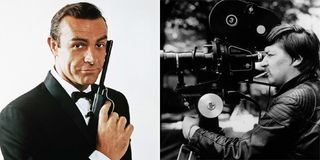How To Do Naval Warfare Without Water And 4 Other Things We Learned About 300: Rise Of An Empire

When Zack Snyder’s 300 came out in 2007 it became the definition of unexpected smash hit. Made for a modest $65 million and featuring a cast lacking in A-listers, the film broke March opening records and ultimately made more than $450 million at the global box office. It’s sequel, 300: Rise of an Empire, has been a long time coming, but now it’s just about ready to blow the universe of 300 wide open.
Telling a different tale set parallel to the Spartan story seen in the first movie, the sequel follows the story of Themistokles (Sullivan Stapleton), an Athenian warrior charged not just with defending his people from the invading Persian armies, but also try to unite the Greek City-States to unite against what seems to be an overwhelming force. At the same time, we also learn the history of the great Greek-Persian conflict and the rebirth of Xerxes (Rodrigo Santoro) as he becomes the God-King of Persia.
Last week I had the chance to attend a press event held in Los Angeles for 300: Rise of an Empire and had the opportunity to sit down one-on-one with the film’s director, Noam Murro. During our conversation he revealed a number of interesting stories and details behind the making of the new film, all of which you can read more about below!

Zack Snyder Would Have Directed 300: Rise Of An Empire Himself Had It Not Been For Man of Steel
The first 300 was such a big success when it came out in 2007 – making $456 million worldwide – that talks about a sequel started up almost immediately… but it still took forever to actually get the follow-up made. While comic book writer Frank Miller worked on a new graphic novel to base the movie on, Zack Snyder and Kurt Johnstad put together a screenplay, and producers like Mark Canton and Gianni Nunnari never lost hope, still the project seemed lost in development hell without a director attached. Things actually nearly got to the point where Snyder was considering just jumping back in the director’s chair and making the movie himself, but then the rebirth of a certain superhero got in the way of that.
When I asked Noam Murro about his pitch for 300: Rise of an Empire that he brought to the producers and the studio to get the job, the director revealed that before he came around there had been some thought that Snyder would just be making the movie himself, but that those plans changed when Snyder signed on to make Man of Steel. With the blockbuster director’s attention focused elsewhere, the door was opened for Murro’s ideas on how to approach the sequel.
"We had a great meeting and we did a bunch of very cool presentations for the studio," Murro said. "There was a specificity to how do you advance the 300, you know, that is a very complicated assignment, because on one hand you have to keep your ties to this incredible piece, but at the same time, you have to make something new. So there were thematic things already that were quite interesting."
CINEMABLEND NEWSLETTER
Your Daily Blend of Entertainment News

Despite Being A Naval Warfare Movie, 300: Rise Of An Empire Had A Completely Dry Set
Along with movies like Sin City and Sky Captain and the World of Tomorrow, the original 300 pushed forward a new form of filmmaking using what was called a "digital backlot." Essentially every scene in the movie was filmed on a stage against a greenscreen and all of the backgrounds were inserted with CGI. Unsurprisingly, as a means of maintaining a franchise aesthetic, this was the same style that was used during the making of 300: Rise of an Empire, but the technique also led to a bit of interesting behind-the-scenes trivia.
Despite the fact that the sequel is a naval war film that has Greek and Persian warriors battling on ships out on the high seas, the extended use of CGI in the movie actually allowed the filmmakers to keep the set 100% dry. "There was not a drop of water on set," Murro said on the Bulgarian production. "So to create a naval war, that is an approach. That’s a big undertaking in terms of trying to solve it from a technical point of view, and an aesthetic point of view, and a pragmatic point of view, and a thematic point of view."
So when you’re at the theater this weekend seeing 300: Rise of An Empire, be sure to stare as closely at the water as you can, know that it’s not really there and embrace just how awesome movie magic is.

James Bond And Rainer Werner Fassbinder On The Road To 300
Looking at Noam Murro’s record, you wouldn’t have necessarily thought that he would be the idea candidate to take on a film like 300: Rise of an Empire. With the exception of a short he directed for HBO in 2009, the filmmaker’s only other directing credit before the sword-and-sandals blockbuster was the 2008 dramedy Smart People starring Ellen Page, Dennis Quaid and Thomas Haden Church. But the real secret to Murro is his want to stretch his bounds as a filmmaker and try something new and different with each project. And behind that aspiration are two very different sources.
Discussing what inspired him to become a filmmaker and the kind of movies he grew up on, Murro told me about his time working as an usher in the Israeli cinematheque and not only being a self-described "big James Bond lover" but also being exposed to the works of Rainer Werner Fassbinder, the German filmmaker best known for films like 1974’s Ali: Fear Eats The Soul and 1979’s The Marriage of Maria Braun.
With his career as a director, Murro hopes to create some akin to what Steven Soderbergh has done, getting the opportunity to show dramatic and aesthetic range with a variety of different projects. "You look at composers that wrote opera and symphony and chamber and pieces for the piano. It’s the same exact thing with film."

James Bond’s Villains Inspired Impact 300: Rise Of An Empire
More than just being what partially inspired Murro to become a filmmaker, the mechanics of a great 007 film also had a direct effect on the director’s mental approach towards certain elements of 300: Rise of An Empire - namely the villain played by Eva Green.
In the movie, Green plays Artemisia, the commander of the Persian navy who has a very legitimate grievance against the Greeks and wants to see their whole society burn to the ground. Though she was born a Greek herself, a life of horror and torture at the hands of the nation’s soldiers built a great rage in her as well as an incredible and insatiable thirst for blood.
In his approach to the character, Murro thought of her as being similar to a James Bond in that he could let her both be unapologetic in her vicious actions while also understanding their mentality and the reason for what they are doing. "No great movie has a villain that you can’t sympathize with. It’s really that simple," Murro told me. "You understand them. You sympathize with them, but you understand how great they are, how dangerous they are. That was part of the discussion was there is no great film here unless there’s a great villain."

Could 300 and 300: Rise Of An Empire Be Edited Together?
300: Rise of an Empire is not your normal kind of sequel. While most follow-ups take place either in the aftermath the events of the first movie and or in a time before it (a.k.a. prequels), the new Greek vs. Persians epic does something a bit different in that it’s set both before, during, and after the Spartan battle portrayed in Zack Snyder’s film. Watching the movie you can’t help but wonder if it would be possible to actually create some kind of supercut that actually bounces back and forth between both movies – and that idea is something that surprisingly entered the minds of the filmmakers behind the film.
Because this very question was something I found myself thinking about while watching 300: Rise of an Empire, I took the opportunity to ask Noam Murro about the possibility and he gave the question a laugh before revealing that it wasn’t the first time he had heard the idea. "Zack was laughing the other day because some of those fans probably will do that, go back and forth," the director said. "We’ll see it online somewhere."
While the project would obviously have to wait until 300: Rise of an Empire comes out on home video (and still probably wouldn’t be 100% legal), this sounds like an interesting idea for an aspiring editor. Could both 300 and 300: Rise of an Empire maintain narrative flow after being stitched together? Perhaps we’ll find out in a few months from now.

Eric Eisenberg is the Assistant Managing Editor at CinemaBlend. After graduating Boston University and earning a bachelor’s degree in journalism, he took a part-time job as a staff writer for CinemaBlend, and after six months was offered the opportunity to move to Los Angeles and take on a newly created West Coast Editor position. Over a decade later, he's continuing to advance his interests and expertise. In addition to conducting filmmaker interviews and contributing to the news and feature content of the site, Eric also oversees the Movie Reviews section, writes the the weekend box office report (published Sundays), and is the site's resident Stephen King expert. He has two King-related columns.
Most Popular








